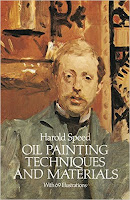 Today we'll take a look at Chapter 8: "Colour: Practical" from Harold Speed's 1924 art instruction book Oil Painting Techniques and Materials
Today we'll take a look at Chapter 8: "Colour: Practical" from Harold Speed's 1924 art instruction book Oil Painting Techniques and MaterialsI'll present Speed's main points in boldface type either verbatim or paraphrased, followed by comments of my own. If you want to add a comment, please use the numbered points to refer to the relevant section of the chapter.
The first half of this chapter is about painting methods, and I'll just present a list of some of the main bullet points.
1. Throwing eyes out of focus vs. squinting
Speed says that the former is better for judging color; the latter for judging value. To be honest, I can't throw my eyes out of focus on command. I can sort of go cross-eyed, but I can't really blur everything out. Anyone have any tips for me?
 |
| Portrait by Harold Speed |
They invented a way to make almost anything paintable. However, Speed reminds us that there are pitfalls to be guarded against: superficiality, slovenly drawing, and neglecting the beauty of deep shadows.
3. "When sunlight is seen in very strong quantities its component prismatic colours can be observed."
He says this is obvious even to the untrained eye. But I'm not quite sure what Speed means. I suppose he means something like a chromatic aberration in a lens. I can't really say I've experienced the colors "unmixing" in my eye. I can see halation effects, especially when I squint, but not the separation into component hues. Speed says that breaking up bright light into prismatic colors is the only way to convey strongly glaring light, but I would suggest that there are other ways, especially those used by JMW Turner and Frederic Church.
Speed then goes on to catalog a variety of painting methods, which I'll just list (for the sake of discussion) rather than try to recapitulate.
4. (page 177) "Method of old tempera painters: Painting color thinly over another repeatedly, thereby getting a play of two colours."
Flesh painted in terra vert (greenish gray) with pinks and ochres thinly painted over. Vermeer's Lady at Virginal painted this way, Speed suggests.
 |
| Harold Speed, Old Tom, courtesy BBC |
Speed reminds us that combining transparent and opaque colors gives the most potential for richness and variety.
6. "All colors are made warmer when painted over light grounds transparently, and all colors are made cooler when mixed with white."
This is a quality of paint mixing that just takes practice. "For sheer beauty of color," he says, "nothing can touch transparent color."
7. Movement in color.
Big topic of this chapter. Speed talks about various ways to make colors change from one passage to another.
8. Finishing hot.
When completing a painting using certain methods, you can't keep retouching it. Speed uses the comparison of driving an old car up a steep hill. If you don't make it over the top of the hill, you have to back up and start all over.
8. Broken color.
Spots of adjacent color that mix in the eye.
9. Mixing several colors on one brush load.
(oil technique) Has anyone tried this?
 |
| Holman Hunt by Harold Speed courtesy BBC. |
12. Pure glazing.
He says it's out of favor, but that beautiful effects can happen that way.
13. Putting a thin border of bright colors around the edges of large masses.
Cecilia Beaux and Wayne Thiebaud (above) comes to mind.
 Next week—We'll follow along with his demo, which starts on page 125.
Next week—We'll follow along with his demo, which starts on page 125.
-----
In its original edition, the book is called "The Science and Practice of Oil Painting ." Unfortunately it's not available in a free edition, but there's an inexpensive print edition that Dover publishes under a different title "Oil Painting Techniques and Materials
." Unfortunately it's not available in a free edition, but there's an inexpensive print edition that Dover publishes under a different title "Oil Painting Techniques and Materials (with a Sargent cover)," and there's also a Kindle edition.
(with a Sargent cover)," and there's also a Kindle edition.
Get my book "Color and Light" signed from my website or from Amazon .
.
----Get my book "Color and Light" signed from my website or from Amazon
GurneyJourney YouTube channel
My Public Facebook page
GurneyJourney on Pinterest
JamesGurney Art on Instagram
@GurneyJourney on Twitter








13 comments:
On a blurry focus try focusing on something further away or closer and then noting what is important in the actual object.
1. I focus at an imaginary distance beyond or through what I am actually looking at, essentially treating the figure as invisible. But, of course, the object/figure is opaque, so I am still seeing the figure as I "look through it". Then the task comes to be aware of what you are actually looking at without refocusing.
Close one eye
Stick out a finger in front, probably around six inches
Focus on it
I'm curious: why doesn't speed ever mention the Hudson River school? Or it might just be me not remembering it. They were quite interested in light effects and getting the actual colors perceived by the eye, if I am not mistaken.
Apart from that, is that painting on a tacky white ground where some modern 'wet-on-wet' painters got inspiration from? Like Bill Alexander for example.
I do have a few questions concerning the methods, specifically, but I guess I will save them for next week and the practical example :)
Separation of light into component hues, especially when looking towards a bright light, can be seen out of ones peripheral vision and or by throwing the eyes out of focus. When looking at a street light, more accurate color can be seen in the halo by looking out of the periphery. Staring or looking at a blank wall makes learning to throw your eyes out of focus easier. Look directly at it then relax your focus. It was easier when I was younger!
Buy some of those magic eye books from the 1990's - if you can do those you'll master the art of throwing everything out of focus. I think Brennen Chua's simple solution is probably the easiest though!
“Hold your finger about eight to twelve inches in front of your eyes and focus on it.
Remove your finger, but keep your focus where it was.”
Kevin MacPherson, Fill Your Oil paintings with Light and Color, Page 21
He does state nearsighted people (as he is) have the advantage, all they have to do is take off their glasses.
1. Throwing my eyes out of focus comes naturally to me, although that may be because when I was younger I actually had a lot of difficulty with the focusing muscles in my eyes. I'm not sure exactly how I do it, so as an experiment I recorded myself doing it. I could definitely see a difference when my eyes went out of focus. They moved farther apart and my pupils dilated. I don't know if that helps. It's basically just letting go of the muscles that control your eyes.
A lens from outdated prescription glasses will do,ask a friend if they have any.
1. David Leffel (a wonderful oil painter) needs reading glasses which he takes off when he paints. That can make things fuzzy.
Fabio said, "I'm curious: why doesn't speed ever mention the Hudson River school? Or it might just be me not remembering it. They were quite interested in light effects and getting the actual colors perceived by the eye, if I am not mistaken."
A good question, Fabio, but you must remember that the book was published in 1924; Speed lived in Britain; not many of the Hudson River paintings had made it to Britain (even in the present day); he was writing for a British audience and therefore would be referring to paintings that his prospective audience might have a chance of seeing, and most of his examples are in the National Gallery, London. I lived in Britain for 34 years, and although I knew of the Hudson River School, I only became really familiar with them after the "American Sublime" Exhibition in London, about 2000 or so, when my eyes were opened to those wonderful paintings; that Exhibition also appeared in Minneapolis (my brother and sister were able to go and see it there), and one other American City. When I read an book of any age I immediately look at the publishing date, and keep that in mind as I read; my love of History helps keep the reading in perspective.
No. 11 - Interesting comment on Titians method there James. In my book "The Materials of The Artist" by Max Doerner, (first published in 1921 Steven:), he talks about the "optical greys" as employed by Leonardo.
"Neutral, "dead" tones were much used by the old masters, as in the "sfumato" of Leonardo, and again in the use of white laid over dark grounds by which the varying thickness of the white layer over the warm, dark undertone resulted in half-tones, the so-called "optical greys". This offered a simple means of plastic modeling."
He goes on to say elsewhere that these "optical greys" have a special quality that cannot be achieved by any other means. Can highly recommend the book too. Rembrandt is reputed to have used the same technique whereby the image was often "ghosted out" with a thin glaze of white, then re-established with subsequent glazes. In my work, the biggest trap was relying too heavily on glazing. My pictures lacked the kind of bones that comes from good drawing. Currently struggling with gouache to help address that imbalance.
No 10 - This technique was used by some watercolourists too, including the Pre-Raphaelites. I think I remember reading that Hunt would use a surface first prepared with Chinese white then lay his watercolour over that. The blush he gets on those plums he so fancied was apparently done that way. Another favourite of mine was Paul Sandby who was similarly reputed to use the same trick in some of his watercolour/bodycolour "landskips". I've not tried it.
Regards Ross
Cross your eyes, then close one eye.
Post a Comment